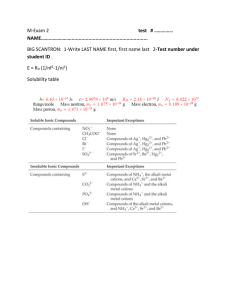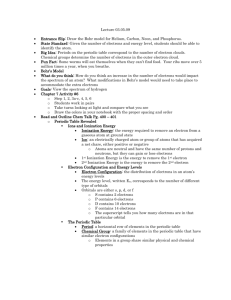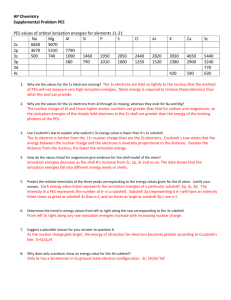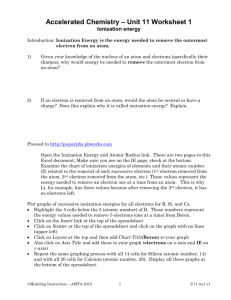Chemistry Study Note - Ionization Energy, Electron
advertisement
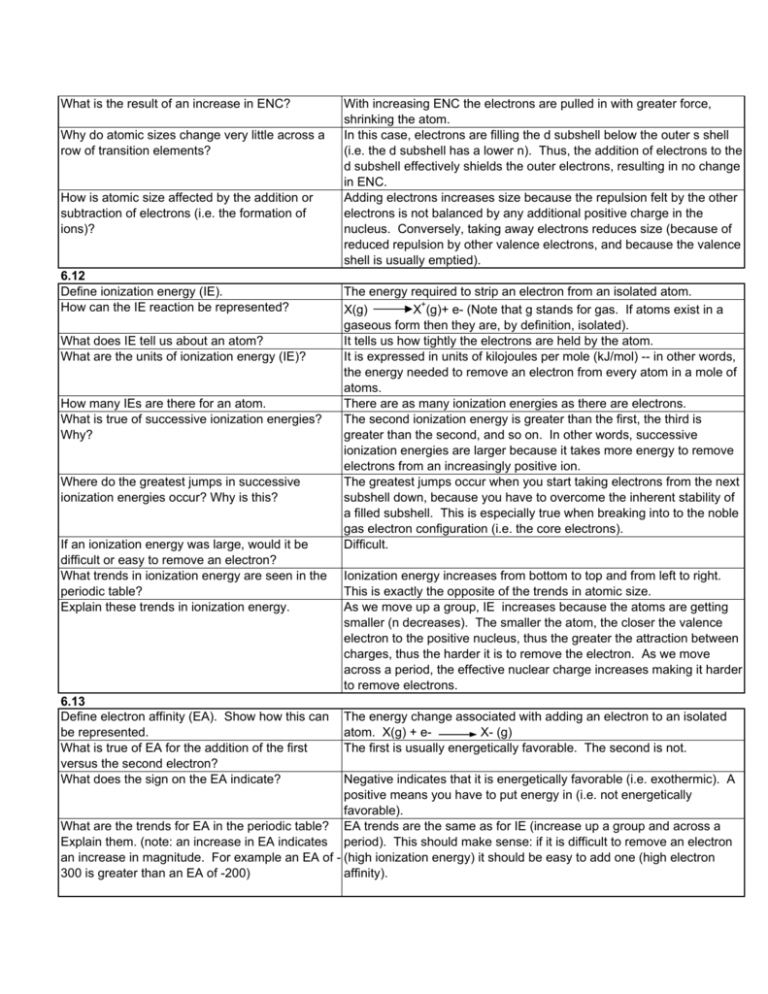
What is the result of an increase in ENC? Why do atomic sizes change very little across a row of transition elements? How is atomic size affected by the addition or subtraction of electrons (i.e. the formation of ions)? 6.12 Define ionization energy (IE). How can the IE reaction be represented? What does IE tell us about an atom? What are the units of ionization energy (IE)? How many IEs are there for an atom. What is true of successive ionization energies? Why? Where do the greatest jumps in successive ionization energies occur? Why is this? If an ionization energy was large, would it be difficult or easy to remove an electron? What trends in ionization energy are seen in the periodic table? Explain these trends in ionization energy. 6.13 Define electron affinity (EA). Show how this can be represented. What is true of EA for the addition of the first versus the second electron? What does the sign on the EA indicate? With increasing ENC the electrons are pulled in with greater force, shrinking the atom. In this case, electrons are filling the d subshell below the outer s shell (i.e. the d subshell has a lower n). Thus, the addition of electrons to the d subshell effectively shields the outer electrons, resulting in no change in ENC. Adding electrons increases size because the repulsion felt by the other electrons is not balanced by any additional positive charge in the nucleus. Conversely, taking away electrons reduces size (because of reduced repulsion by other valence electrons, and because the valence shell is usually emptied). The energy required to strip an electron from an isolated atom. + X(g) X (g)+ e- (Note that g stands for gas. If atoms exist in a gaseous form then they are, by definition, isolated). It tells us how tightly the electrons are held by the atom. It is expressed in units of kilojoules per mole (kJ/mol) -- in other words, the energy needed to remove an electron from every atom in a mole of atoms. There are as many ionization energies as there are electrons. The second ionization energy is greater than the first, the third is greater than the second, and so on. In other words, successive ionization energies are larger because it takes more energy to remove electrons from an increasingly positive ion. The greatest jumps occur when you start taking electrons from the next subshell down, because you have to overcome the inherent stability of a filled subshell. This is especially true when breaking into to the noble gas electron configuration (i.e. the core electrons). Difficult. Ionization energy increases from bottom to top and from left to right. This is exactly the opposite of the trends in atomic size. As we move up a group, IE increases because the atoms are getting smaller (n decreases). The smaller the atom, the closer the valence electron to the positive nucleus, thus the greater the attraction between charges, thus the harder it is to remove the electron. As we move across a period, the effective nuclear charge increases making it harder to remove electrons. The energy change associated with adding an electron to an isolated atom. X(g) + eX- (g) The first is usually energetically favorable. The second is not. Negative indicates that it is energetically favorable (i.e. exothermic). A positive means you have to put energy in (i.e. not energetically favorable). What are the trends for EA in the periodic table? EA trends are the same as for IE (increase up a group and across a Explain them. (note: an increase in EA indicates period). This should make sense: if it is difficult to remove an electron an increase in magnitude. For example an EA of - (high ionization energy) it should be easy to add one (high electron 300 is greater than an EA of -200) affinity).

